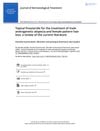TLDR Topical finasteride cream reduces hair growth perception in women with idiopathic hirsutism.
The study investigated the effects of topical finasteride on idiopathic hirsutism in 38 women aged 18-52 years. Participants were divided into four response groups based on subjective evaluations of hair growth rate, hair density, and hair color changes. The study found a significant reduction in hair removal frequency (P<0.001) after using 1% finasteride cream for 3 months, although there were no significant changes in hair color or thickness after 6 months of using 0.5% finasteride. Despite the lack of objective changes, most participants perceived a decrease in hair growth over time.
April 2021 in “Texila international journal of academic research” Both topical and oral finasteride are equally effective for treating male pattern baldness.
 13 citations
,
June 2020 in “Journal of Dermatological Treatment”
13 citations
,
June 2020 in “Journal of Dermatological Treatment” Topical finasteride helps regrow hair and reduce hair loss in men and women.
June 2020 in “The Medical Journal of Cairo University” Topical spironolactone works better than topical finasteride for hair loss.
6 citations
,
August 2012 in “PubMed” Finasteride may effectively treat female pattern hair loss.
May 2008 in “10th European Congress of Endocrinology” 4 citations
,
January 2007 in “Iraqi postgraduate Medical Journal”  62 citations
,
April 2004 in “Expert Opinion on Pharmacotherapy”
62 citations
,
April 2004 in “Expert Opinion on Pharmacotherapy” Finasteride effectively treats male pattern baldness, improving hair growth and density.
January 2001 in “Journal of Dermatology and Venereology” Finasteride helps prevent hair loss and promote hair growth.
 1 citations
,
January 2001 in “Endocrine Practice”
1 citations
,
January 2001 in “Endocrine Practice” Topical finasteride may help treat facial hirsutism in women.


